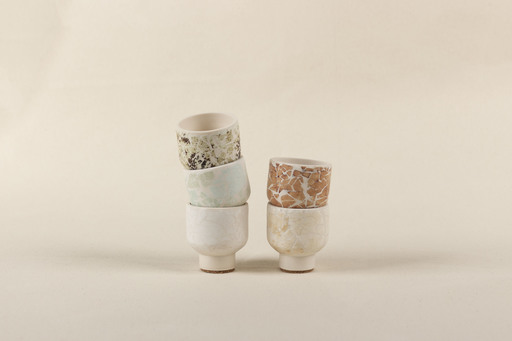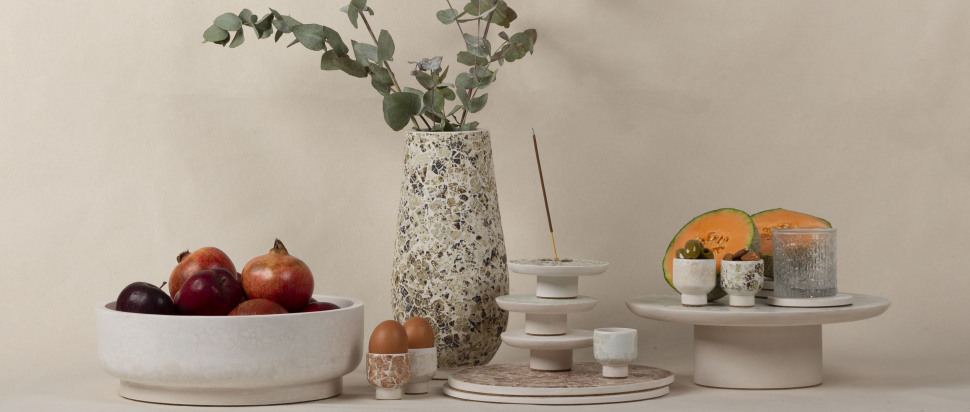Local Heroes: Isla Cruickshank's sustainable homeware
Glasgow-based designer Isla Cruickshank tells us how her family culinary background informs her work in jewellery and homeware design
How has being raised by a family of talented cooks influenced your approach to design?
I learned how to cook from a very young age from my Grandma and my Mum. I was always a creative kid and cooking felt like another outlet, exploring creativity through food. My awareness of how creativity could bleed into various activities led me to have an open mind about what design could be. My Mum and Grandma were also always so aware of waste and so efficient in the kitchen. This directly links to my approach in cooking and making. I like to think I am curious with material, being conscious and problem solving. This element of practicality within my creative practice I learned from home cooking and growing up rurally.
Your work challenges our perceptions of waste – how did this theme emerge and where is it going in the future?
It certainly wasn’t intentional, but it quite naturally appeared within my practice mid-way through my degree. I have been working as a private freelance cook since 2016, and doing this alongside my studies meant that my practice began honing in on themes such as waste and materiality at that stage. I was becoming increasingly aware of the amount of waste from the kitchens I was working within and particularly materials that became redundant after consumption, such as eggshells. I genuinely feel like there is a wealth of potential in food as a material and we should be encouraging design that is actively considering it as sustainable material solutions for our future. I would like my material focus to expand greatly in the future and allow the brand to display a wider example of what is possible within this field.
Where do your colour palettes come from and what process do you use to dye the shells?
My colour palette all comes from natural sources. Most eggshells contain natural pigment, such as the Araucana, duck, quail, and Bantom eggs. I also wanted to explore the process of natural dyeing with food waste, further exploring the ability of food as a material and an element of process. I have done countless vegetable experiments that achieve varying tones on your everyday brown eggshells. This involves creating the dye by soaking and boiling vegetable waste and then allowing the dye to develop over time on the eggshells by soaking for anything from a few hours to a couple days. All ingredients are 100% natural and the process is mainly determined by the time soaking.

What other aspects of your making processes have sustainability at their heart?
I have made a real effort to keep sustainability at the heart of and.ilc. Alongside the eggshell inlay, I chose supporting materials that continue this focus. Brass and jesmonite are the two main components of this. I have always had slight concerns with precious metals and the ethical issues that can come with them. Although there are better recycled and eco options these days, brass allows me to work with a metal that is mainly dependable on the recycling of scrap. Jesmonite is a water-based and environmentally friendly substitute to other resins and the non-toxic nature of jesmonite makes it an eco-resin.
Do you have any exhibitions or events coming up in 2022?
My jewellery is currently on show in London at the Goldsmiths centre, in their Emerging Maker exhibition. This is a physical showcase that followed on from the online and social media emerging makers feature in early 2021. Sadly, I was also due to have both jewellery and homeware pieces in the Visual Art Scotland annual exhibition this January but unfortunately COVID saw this exhibition cancelled. I am hoping that 2022 will provide more opportunity for exhibiting and for people to see my work in person.
What was your highlight of 2021?
I was delighted to receive the Jorum Craft Award early in 2021, which helped me develop my homeware collection and generally explore my practice on a larger scale. This award was a great catalyst for further exposure, and I was honoured to be featured on both the Craft Scotland website and as a Scottish emerging maker to watch in The Skinny’s website.
Where can we see and buy your work?
You can see and buy my work on my website andilc.com as well as my stockists, The Barn in Banchory and Prior shop in Bristol. Follow me and my process behind the scenes on my instagram @and.ilc
